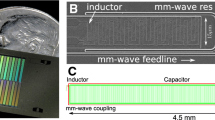Abstract
The third-generation upgrade to the receiver on the South Pole Telescope, SPT-3G, was installed at the South Pole during the 2016–2017 austral summer to measure the polarization of the cosmic microwave background. Increasing the number of detectors by a factor of 10 to \(\sim 16,000\) required the multiplexing factor to increase to 68 and the bandwidth of the frequency-division readout electronics to span 1.6–5.2 MHz. This increase necessitates low-thermal conductance, low-inductance cryogenic wiring. Our cold readout system consists of planar thin-film aluminum inductive–capacitive resonators, wired in series with the detectors, summed together, and connected to 4K SQUIDs by \(10-\upmu \hbox {m}\)-thick niobium–titanium (NbTi) broadside-coupled striplines. Here, we present an overview of the cold readout electronics for SPT-3G, including assembly details and characterization of electrical and thermal properties of the system. We report, for the NbTi striplines, values of \(R \le 10^{-4} \Omega \), \(L = 21 \pm 1~\hbox {nH}\), and \(C = 1.47\pm .02~\hbox {nF}\). Additionally, the striplines’ thermal conductivity is described by \(kA = 6.0\pm 0.3 \ T^{0.92 \pm 0.04}~\upmu \hbox {W}~\hbox {mm}~\hbox {K}^{-1}\). Finally, we provide projections for cross talk induced by parasitic impedances from the stripline and find that the median value of percentage cross talk from leakage current is 0.22 and \(0.09\%\) from wiring impedance.





Similar content being viewed by others
Notes
NbTi rolled by Rikazai Co., Ltd, and stripline manufactured by PrimeTech Corporation.
We used the Cerasolzer USS-9210 Ultrasonic Soldering System and Cerasolzer CS297-150 solder.
References
B.A. Benson, P.A.R. Ade, Z. Ahmed, S.W. Allen, K. Arnold, J.E. Austermann, A.N. Bender, L.E. Bleem, J.E. Carlstrom, C.L. Chang, et al., Spt-3g: a next-generation cosmic microwave background polarization experiment on the south pole telescope, in SPIE Astronomical Telescopes + Instrumentation, International Society for Optics and Photonics, (2014), pp. 91531P–91531P
A.N. Bender, P.A.R. Ade, A.J. Anderson, J. Avva, Z. Ahmed, K. Arnold, J.E. Austermann, R. Basu Thakur, B.A. Benson, L.E. Bleem, et al., Integrated performance of a frequency domain multiplexing readout in the spt-3g receiver, in International Society for Optics and Photonics Millimeter, Submillimeter, and Far-Infrared Detectors and Instrumentation for Astronomy VIII, vol. 9914, (2016), p. 99141D
A.N. Bender, J.-F. Cliche, T. de Haan, M.A. Dobbs, A.J. Gilbert, J. Montgomery, N. Rowlands, G.M. Smecher, K. Smith, A. Wilson, Digital frequency domain multiplexing readout electronics for the next generation of millimeter telescopes. in SPIE Astronomical Telescopes+ Instrumentation, International Society for Optics and Photonics, (2014), pp. 91531A–91531A
M.A. Dobbs, M. Lueker, K.A. Aird, A.N. Bender, B.A. Benson, L.E. Bleem, J.E. Carlstrom, C.L. Chang, H.-M. Cho, J. Clarke et al., Frequency multiplexed superconducting quantum interference device readout of large bolometer arrays for cosmic microwave background measurements. Rev. Sci. Instrum. 83(7), 073113 (2012)
K. Hattori, Polarbear collaboration, et al., Frequency domain multiplexed readout of kilopixel arrays of transition edge sensor bolometers, in Society of Photo-Optical Instrumentation Engineers (SPIE) Conference Series, Society of Photo-Optical Instrumentation Engineers (SPIE) Conference Series, (2014)
K. Rotermund, B. Barch, S. Chapman, K. Hattori, A. Lee, N. Palaio, I. Shirley, A. Suzuki, C. Tran, Planar lithographed superconducting lc resonators for frequency-domain multiplexed readout systems. J. Low Temp. Phys. 184(1–2), 486–491 (2016)
Acknowledgements
The South Pole Telescope is supported by the National Science Foundation (NSF) through Grant PLR-1248097. Partial support is also provided by the NSF Physics Frontier Center Grant PHY-1125897 to the Kavli Institute of Cosmological Physics at the University of Chicago, and the Kavli Foundation and the Gordon and Betty Moore Foundation Grant GBMF 947. Work at Argonne National Laboratory, including Laboratory Directed Research and Development support and use of the Center for Nanoscale Materials, a U.S. Department of Energy, Office of Science (DOE-OS) user facility, was supported under Contract No. DE-AC02-06CH11357. Work at Fermi National Accelerator Laboratory, a DOE-OS, HEP User Facility managed by the Fermi Research Alliance, LLC, was supported under Contract No. DE-AC02-07CH11359. NWH acknowledges support from NSF CAREER Grant AST-0956135. The McGill authors acknowledge funding from the Natural Sciences and Engineering Research Council of Canada, Canadian Institute for Advanced Research, and Canada Research Chairs program.We acknowledge R. Divan, L. Stan, C.S. Miller, and V. Kutepova for supporting our work in the Argonne Center for Nanoscale Materials. D. Barron is supported by an NSF Astronomy and Astrophysics Postdoctoral Fellowship under award AST-1501422. This material is based upon work supported by the National Science Foundation Graduate Research Fellowship under Grant Nos. DGE 1752814 and DGE 1106400. Useful conversations are acknowledged with Xiaoyu Guo.
Author information
Authors and Affiliations
Corresponding author
Rights and permissions
About this article
Cite this article
Avva, J.S., Ade, P.A.R., Ahmed, Z. et al. Design and Assembly of SPT-3G Cold Readout Hardware. J Low Temp Phys 193, 547–555 (2018). https://doi.org/10.1007/s10909-018-1965-5
Received:
Accepted:
Published:
Issue Date:
DOI: https://doi.org/10.1007/s10909-018-1965-5




